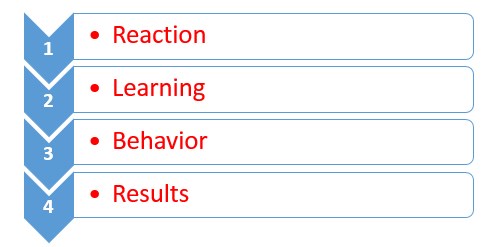Benefits Kirkpatrick’s Evaluation Model
Donald Kirkpatrick first published his Four-Level Training Evaluation Model in 1959. To this day, it is still one of the most popular models to evaluate training program. Kirkpatrick’s model evaluates the effectiveness of the training at four different levels with each level building on the previous level(s).
The four levels of evaluation are:
- Reaction
- Learning
- Behavior
- Results
Four Levels of Evaluation
Kirkpatrick’s model includes four levels or steps of evaluation:
Level 1: Reaction – To what degree did the participants react favorably to the training
Level 2: Learning – To what degree did the participants acquire the intended knowledge, skills, and/or attitudes based on their participation in a training
Level 3: Behavior – To what degree did the participants apply what they learned during training to his/her job
Level 4: Results – To what degree did the targeted objectives/outcomes occur as a result of the training.

Benefits Kirkpatrick’s Evaluation Model
Level 1 – Reaction
This level measures how the participants reacted to the training event.
Benefits of level one evaluation:
- It is generally easy and inexpensive to complete
- Immediate feedback to training event
- It attains a gauge on how the participants felt about the training
- Identifies areas that the participant felt were missing from the training
- It can provide information on specific aspects of the training
- It can provide information that can be used to improve future versions of the training
- Provides a simple way to gauge a perceived return on the training investment
Level 2 – Learning
Level two evaluation measures what the participants have learned as a result of the training.
Benefits of level two evaluation:
- Provides opportunity for learner to demonstrate the learning transfer
- Quantifies the amount of learning as a result of the training
- Provides more objective feedback then level one evaluations
- Provides more conclusive evidence of training effectiveness
- Identifies gaps between the targeted objectives and actual learning
- The assessment information can be used to increase learning in future training programs
Level 3 – Behavior
Level three measures how much participants have changed their behavior as a result of the training they received.
Benefits of level three evaluation:
- Provides measurement of actual behavior change occurring on the job
- Measures more than just a positive reaction or short term learning
- It can show gaps between training and on the job performance
- It illustrates organization willingness to change
- It is objective evidence to support the effectiveness and value of a training program.
Level 4 – Results
Level four evaluation measures the impact of training and subsequent reinforcement by the organization on business results.
Benefits of level four evaluation:
- Measures affect training has to ultimate business results
- Illustrates value of training in a monetary value
- Ties business objectives and goals to training
- Depicts the ultimate goal of the training program
Additional Links
Gagnes Nine Events Instruction
Kirkpatricks Four Levels of Evaluation
